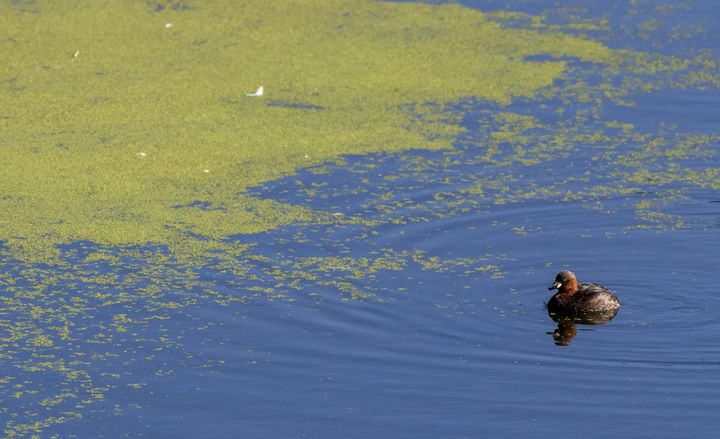
It might look relatively harmless, but swimmers – and any swimming dogs – need to watch out for blue-green algae this summer.
The National Trust recently found it at both Portstewart and Castlerock, two of Northern Ireland’s most popular north coast beaches.
It was first reported to the Northern Ireland Environment Agency at Castlerock Beach on 5 July by the Department of Agriculture, Environment and Rural Affairs, who then confirmed it was likely to be a toxic species.
The beaches now been marked as unsafe for bathing by the RNLI. The charity has awarded a red flag status to the area, meaning people should not enter the water under any circumstances.
However, the BBC reported that the beaches in question were still marked as “fully open” – so here’s what you need to know about the dangerous substance this summer, to make sure you’re able to spot it yourself.
What is toxic blue-green algae?
It’s a term used to describe a group of bacteria, called cyanobacteria, which are really small and can’t be seen with the naked eye, according to Public Health Wales.
As NHS Scotland says: “Some, but not all, blue green algae release toxins (poisonous chemicals) into the water. It is not possible to tell which algae do or do not produce toxins without close examination in a laboratory. ”
It’s also not actually algae – but it does looks quite like it, because the naturally-occurring organisms clump together when they multiply, forming a “bloom” when the conditions are just right (ie. the water is warm and nutritious).
The toxin normally gathers in non-flowing fresh water, like lakes, ponds and rivers (places people and dogs usually go swimming), and it can occur all year round.
But it’s a particular problem when hot weather and pollution strike together at the same time, as it means the algae can bloom rapidly – and then the wind can spread it onto nearby riverbanks.
It can be fatal to pets – a number of dog deaths have already been reported – and cause illness if touched or swallowed.
As Public Health Wales explains: “There are no quick or easy remedies for the control of blooms once they appear in a lake or pond.”
How is blue-green algae harmful?
NHS Scotland explains that in a human, you can come out in skin rashes, eye irritation, vomiting, pains in muscles and joints, fever and headaches.
There were no reports of long-term illnesses or deaths in human, but the illnesses can be severe.
Blue Cross animals charity explains that in dogs, it can be fatal. The toxins can stop a dog’s liver functioning properly, and lead to long-term health problems even if the pet survives.
The symptoms can appear just 15 minutes to an hour after the dog ingests or swims in the toxic water.
The signs include vomiting, diarrhoea, seizures, fitting, weakness, collapse or unconsciousness, disorientation, confusion, drooling and breathing difficulties.
These aren’t rare symptoms and can be confused with other illnesses, but it’s worth calling your vet if you’re worried. There’s no antidote, but your vet could make your pet sick to expel the toxins from the body if you catch it early enough.
It can also be toxic to cats, birds and livestock so get in touch with your vet if you see them drinking potentially contaminated water.
There’s also a risk to animals even if they don’t swallow the contaminated water. NHS Scotland says: “Deaths of dogs and livestock have been put down to blue green algae when they appear to have only entered the water and the shores of lochs, which were affected with algal scum. ”
How do you spot algae?
The toxin can look slightly different in different bodies of water, but it always grows on the surface.
The Blue Cross says that in some cases, it looks like a “pea soup”.

On other occasions, the contaminated body of water can have green flakes or greenish bundles brown dots.
It can foam around the edges or the body of water, too, or even look it can look like paint on the surface of the water, varying in colour from green, blue green to green-brown.

Another warning sign is dead fish in the body of water, which might suggest a high concentration of toxin.
How can you protect yourself (and animals) from the toxin?
The best way to protect yourself – and your pets – is to stay away from lakes or ponds which you know or suspect contain the algae, and definitely don’t drink from the water containing it.
It might be worth fencing off suspected waters to protect farm animals from illness, too.
The natural movement of the tides should help break down the algae eventually, but this will mean the blooms wash up on the shore, so the water’s edge or shore line can be the most dangerous place sometimes.
Try to prevent your dog from going near contaminated bodies or water, as well as swimming in them.
The NIEA has called on the public to get involved in citizen science and monitor the algae’s growth.
There’s also Bloomin’ Algae App which lets people submit photos of the bloom so specialists can assess the risk the contamination poses to the public.